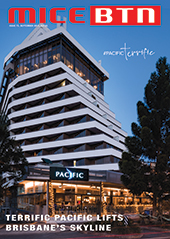Travel buying is becoming more complicated – and will be more expensive in 2018, says CWT/GBTA
- BTN News
- Wednesday, 19 July 2017
Travel prices are expected to rise sharply in the coming year with near-four per cent increases in some sectors, according to the 2018 Global Travel Forecast from Carlson Wagonlit Travel and the GBTA Foundation.
The Forecast shows global airfares are expected to rise 3.5 per cent in 2018, hotel prices are to be 3.7 per cent higher, with ground transportation (taxis, trains and buses) expected to rise by 0.6 per cent.
Air travel
The uptick in global air fares is in spite of airlines adding an expected six per cent capacity in 2018. Complicating airline pricing is increased segmentation of basic fares among large carriers. Travellers now have the option of choosing a basic economy, restricted fare versus various upgraded fares, with specific service options and pricing varying by airline.
- Asia Pacificexpects to see a 2.8 per cent rise in 2018 prices, with domestic demand increasing, particularly in China and India. However, as many of the economies in Asia strengthen, weaknesses in infrastructure – and airports in particular – are increasingly apparent.
- Across EMEA, air travel is anticipated to continue growing, with prices rising 7.1 per cent across Eastern Europe and 5.5 per cent in Western Europe. However, Middle East and African countries only expect a 3.0 per cent increase as they face ongoing security threats and an oil industry that is still in recovery. Currency fluctuations in Europe may further impact airfares in 2018. Given limited competition and the upcoming summer 2018 World Cup in Russia, Eastern Europe may again have the most significant price increases in the region.
- Across Latin Americaand the Caribbean, prices are expected to change little in 2018 – up only 0.3 per cent. Airlines have cautiously added capacity back into the market. Broader analysis of South America shows a 20 per cent increase in scheduled flights by the end of 2019. Low cost carriers are well positioned for this area given the low penetration in the region. And, new, more efficient aircraft coming into operation will lower operating costs in 2018.
- North Americawill see prices rise by a modest 2.3 per cent. Citing the potential for stronger US travel restrictions, flights to the United States have already been reduced. Canadian airlines are expected to aggressively compete given new market entrants and capacity growth of about 11.0 per cent in 2017 and 12.0 per cent in 2018. With the region’s air travel market nearly flat year-over-year in early 2017, competition is fierce between carriers who now compete on branded fares rather than on bundled fares or by carrier type.
2018 hotel projections
Globally, the 3.7 per cent average increase in hotel prices masks what is actually happening on a regional level. Europe is expected to post strong increases, while other regions are barely keeping up with inflation. Additionally, prices are expected to fall in Latin America and the Caribbean. CWT expects the impact of 2017 mergers will be felt during the 2018 RFP season.
Suppliers are progressively moving corporate buyers away from fixed, negotiated hotel rates and toward dynamic rate pricing. There is also a global trend towards 'smarter' hotels, with hotels investing in beacon technologies, messaging, in-room entertainment and more.
- Across Asia Pacific, hotel prices are tipped to rise 3.5 per cent - with a large discrepancy as Japanese prices are expected to fall 4.1 per cent, but New Zealand is set to rise a full 9.8 per cent. Strong economies means demand is increasing in the APAC region. Buyers should anticipate a more challenging discussion with newly merged hotel groups, especially in high-volume markets such as Bangkok, Beijing, Shanghai and Singapore.
- AcrossEMEA, hotel prices are likely to rise - 6.6 per cent in Eastern Europe, 6.3 per cent in Western Europe, but only 0.6 per cent in the Middle East and Africa. Norway is expected to lead with increases of 14.0 per cent expected for 2018, while Russian hotel prices will rise 11.9 per cent due to increased demand from hosting the 2018 Summer World Cup.
- Within Latin America, hotel prices are expected to fall 1.2 per cent, with steep declines in Brazil (down 8.7 per cent) and Argentina (down 2.7 per cent). However, Peru and Chile are expected to see 7.7 and 5.5 per cent increases, respectively. Buyers may see efficiencies in 2018 as bigger brands purchase independents and upgrade systems. Capacity is being added throughout the region with an estimated 449,500 new hotel rooms being constructed between late 2016 and 2025 – a 57.0 per cent increase in supply. Sharing economy accommodations are still not very popular for corporate travel in Latin America, given structural security concerns.
- North Americahoteliers may be banking on economic growth as demand has leveled off since mid-summer 2016 – but supply is expected to continue growing steadily through 2018. With international travel projected to grow 4.0 per cent in 2017 and 2018, US hotel growth is expected to be concentrated primarily along with the West Coast and in Washington DC. In Canada Toronto, Vancouver and Montreal are expected to maintain good pricing power amid a weak Canadian dollar.
Ground transportation projections
Ground transportation pricing is expected to rise only 0.6 pre cent in 2018 (but 5.5 per cent by 2022). Industry experts predict record new car sales over the next five years will push up per unit fleet costs, while used car pricing is expected to fall 50 per cent, hurting residual value for used rental cars and making current rental car pricing unsustainable. Market-specific regulations for curbing emissions, and rising oil prices have suppliers’ already increasing availability of 'green' rental cars.
Sharing economy players such as Uber and Lyft are expected to continue double-digit growth upwards of 10.0 per cent in 2018, before settling down into single-digit growth for 2019. Their growth is under threat by costly regulation and government bans.
- Continued uncertainty in mining, and a cautious recovery in the oil and gas industry will result in flat rates for 2018 in Asia Pacific. Business continues to grow in China as most major car rental and sharing economy suppliers have a presence. Sharing economy suppliers Didi Chuxing in China, Ola in India and Grab in Southeast Asia have all achieved economies of scale that make them key competitors to more-traditional car rentals firms and taxis.
- Ground transportation remains very competitive in EMEA. Prices are expected to remain mostly flat in Europe, and up just one per cent across the Middle East and Africa. Rail continues to be a viable alternative to air travel throughout Europe, especially with enhanced security at airports.
- Prices are expected to rise slightly (1.0 per cent) across Latin America. Brazil and Mexico are anticipating increased demand for car rentals in 2018 as their economies rebound. However, the rental car market there is still heavily fragmented. Uber is betting big on its Latin American business (despite issues in Brazil, Peru and Argentina) – especially after its recent departure from the Chinese market. Regional and international rental companies continue to expand and pricing is expected to stabilise.
- Canada is expected to see a healthy 4.6 per cent increase in 2018, but the overall region will only be up 1.0 per cent. Limited railways, along with improved income per capita and increased corporate travel, are expected to push up rental car rates in North America. Still a low-margin business, rental car companies have implemented operational efficiencies and made investments in technology to better manage fleets and improve utilisation. Sharing economies continue to grow, but face improved competition from traditional cabs and government regulation.
“The higher pricing is a reflection of the stronger economy and growing demand,” said Kurt Ekert, president and chief executive, Carlson Wagonlit Travel. “The global numbers from this forecast should be considered strong leading indicators of what 2018 will mean for global businesses, as we anticipate higher spending.”
“Geopolitical risks, uncertainties in emerging markets and ever-changing political environments in Europe and the United States mean today’s travel professionals have more than ever to take into account when building their travel programs,” said Jeanne Liu, GBTA Foundation vice president of research.










